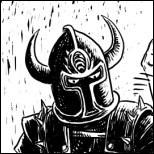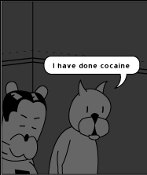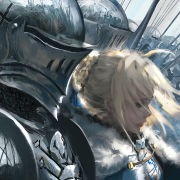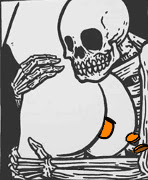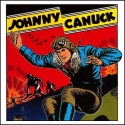|
What is the best source for a 1e / OSR "Beholder"? Is it just the 1E Monster Manual?
|
|
|
|

|
| # ? Jun 5, 2024 06:37 |
|
It's my understanding that I, Tyrant was an AD&D 2e Beholder sourcebook. For free, you want to get Labyrinth Lord's Advanced Edition Companion, which has the "Eye of Terror" as totes-not Beholder, but LL is a B/X retroclone, so that Beholder is technically a monster written under base AC 9 rules. I don't think OSRIC did a not-Beholder for full 1e compatibility.
|
|
|
|
gradenko_2000 posted:It's my understanding that I, Tyrant was an AD&D 2e Beholder sourcebook.
|
|
|
|
I'd like to ask for some help, thread. I recall a story, possibly even from this same thread, about a module where the party gets attacked by dozens and dozens of either kobolds or goblins or some such other fodder-class humanoid, and the playing group either didn't know that the AD&D Fighter gets multiple attacks against >1 hit dice creatures and so they had to pull off some exceptional stunts to pull through, or they did and acknowledge that it would've been a slog had that rule not existed. Anyone know what module(s) have that kind of scene?
|
|
|
|
I know Barrier Peaks has Vegepygmies and dogs as a random encounter. Something like 14-24 vege's and up to 5 dogs. With two entries per table it can happen frequently.
|
|
|
|
gradenko_2000 posted:I'd like to ask for some help, thread.
|
|
|
|
I finished the piece I was writing, tracing the history of the Fighter gaining additional attacks against low-level enemies.
|
|
|
|
gradenko_2000 posted:I finished the piece I was writing, tracing the history of the Fighter gaining additional attacks against low-level enemies. This is really cool. Seeing this stuff makes me really appreciate the streamlining and rules clarity of the OSR.
|
|
|
|
gradenko_2000 posted:I finished the piece I was writing, tracing the history of the Fighter gaining additional attacks against low-level enemies. Speaking of hundreds of goblins, I rolled up a 0ed dungeon and did indeed get all my monster groups as over 100 creatures. That doesn't seem game-able. Certainly if you were going around with an army you would leave them at the door as an adventurer. The rules make it clear that this is an expected result, but what is the intention of how to play it? And how would you actually run it?
|
|
|
|
If you're not willing to reduce the numbers to what's "normal" for a single room (just drop the x10 multiplier), my proposal is to make an entire dungeon/adventure out of that single monster roll. This is actually going to be the basis for my next piece, so you get a sneak peek: Using OD&D's Book II - Monsters & Treasure, a roll of [4d10*10] to generate the number-appearing for goblins/kobolds is going to give you 220 goblins on average. You're also told that one of those goblins is going to be a Goblin King, and they will have [5d6] number of bodyguards, and that both the King and their bodyguards will have the stats of Hobgoblins, the important part being that Hobgoblins have [1+1] HD. Let's take the average of that 5d6 bodyguards roll and assume there's 17 of them, plus one King, which gives us 202 "normal" goblins. If we assume that 1 goblin is worth 50 XP, and that 1 king/bodyguard is worth 100 XP, using the base principle of 100 XP per full HD as in Men & Magic, then [(50 * 202) + (100 * 18)] gives us a total of 11 900 XP. Divided among four adventurers, that's 2 975 XP each, or enough to get all three classes to level 2, with the Cleric almost getting up to level 3. And that's not yet counting all of the loot from the monsters: 1d6 GP per goblin would yield 770 GP on average, for another 192 XP per character once it's been divided among four. Your Cleric gets to level 3, and that's if you never distribute a hoard or loot pile. The Greyhawk XP rules are much more stingy, but again that assumes that you never leave any loot piles. And yes, it's a lot of combat to work your way through slaying 220 goblins even if you never add another monster, but throw in morale rules, player-made traps, and all that other stuff that people tend to invent to cause mass casualties and you should be able to run a two-to-three session adventure of "assault the goblin warrens" where it's a three-level dungeon filled with goblins. Start with your "Master Counter" of 220, subtract two when they kill the two guards on the outskirts, subtract six per guard tower, subtract another two sentries posted on the actual entrance, subtract twenty once the party asphyxiates a whole mess-hall via smoke inhalation, subtract five every time they beat back a random encounter roll, subtract another four once the players raid an armory, subtract another ten once they take so long checking for equipment that reinforcements arrive, and so on and so forth. At one point they'll have to fight a bodyguard on the first level.
|
|
|
|
gradenko_2000 posted:If you're not willing to reduce the numbers to what's "normal" for a single room (just drop the x10 multiplier), Oh, for pete's sake, I knew there was something off about rolling 40d10 to determine a monster grouping. This is certainly how I will populate 'The Underworld'. As for your other idea however, I had already been thinking that if a map hex was pre-rolled for 'monster theme', so to speak, you could end up with a similar result. So you would have 294 orcs or bandits patrolling around the hex, and they would have a cave or motte and bailey base to operate from, with lieutenants and treasure as described. Then you could roll a couple companion creatures, either from the main chart, or from the 'castle guards' for them to team up with. gradenko_2000 posted:The Greyhawk XP rules are much more stingy, but again that assumes that you never leave any loot piles. It's really amusing to me that the experience rule was singled out as being "(ridiculous)" in a game chock full of ridiculous things.
|
|
|
|
The dungeon encounter tables in the DMG and the Fiend Folio give much more reasonable numbers of creatures like goblins for an individual party-to-party combat scenario: a goblin encounter can be expected to feature 6-15 (1d10+5) goblins, and will rarely be encountered outside of dungeon level I. Other humanoid monsters follow similar trends: a dungeon encounter with gnolls will be with 4-10 (2d4+2) gnolls, not the 20-200 appearing in their Monster Manual entry. I think it's fair to read the OD&D/1e "number appearing" as meaning the total number of that creature found in the entire dungeon. The Fiend Folio and Monster Manual II both try to clarify what that number means, though MM2 creates as much confusion as clarity. The FF says that the number listed is the number to be found near their lair, with smaller numbers appearing elsewhere; MM2 says that larger numbers are found closer to the creature's lair and smaller numbers are found farther away, but that could be read just as easily to mean that you'd actually encounter even more of the creature than the number listed as appearing if found near their lair. That said, both books make it clear that the number listed is for overland adventuring only, not for dungeon crawls; "No. Appearing" is a warband-sized encounter suitable for wargaming, which fits with the expectations of OD&D's Chainmail compatibility and with the assumption in 1e that adventuring parties will be accompanied by their own warbands of followers at higher levels and will wisely avoid combat whenever possible at lower levels. Interestingly, both BECMI and 2e drop the numbers listed in the 1e "No. Appearing" block in favor of subbing in different, smaller numbers to be featured in encounters, which (as far as I can tell) aren't derived from the DMG's dungeon encounter tables at all. A goblin encounter is with 4d6 goblins in 2e, and the 40-400 figure is used specifically as the number of adult warriors found in an entire goblin tribe. B/X and BECMI/Rules Cyclopedia specifically break the "number appearing" block down both into the individual encounter and the number found in their lair: in the case of goblins, 2d4 and 6d10 respectively in Moldvay, 1d6 and 3d6 in Mentzer, and 2d8 and 6d10 in the Rules Cyclopedia. (The Moldvay figure of 2d4 goblins in an encounter originates with the encounter tables in the Holmes blue box basic set, which doesn't differentiate between encounter types like the later Basic-derived material does.)
|
|
|
|
The overland encounter tables in DMGR2 Creature Catalogue, the monster book for the Rules Cyclopedia, use the same number appearing for a wilderness encounter with a creature as is given for the number of that creature that would be encountered in its lair in the RC (6d10 goblins, 3d6 gnolls, etc). So it does seem like at least some sources used the larger number to indicate larger groupings of that particular creature that appear in the area, whether it's in the creature's lair or on the march. I guess you would encounter 40-400 goblins at once, if you went directly into the goblins' lair - although their % In Lair listing in the 1e MM indicates that only 40% of them (16-160) would actually be there at the time. (Unless you treat the % In Lair as a binary, in which case that's the chance that you'd encounter zero goblins in the lair of upwards of 400 goblins - a ridiculous scenario, but one that's a legitimately plausible reading of the rules as written.)
|
|
|
|
A lot of OSR games I know of give separate listings for number encountered in a small group (the average one dungeon room encounter) and another for creatures encountered in the wilderness (which usually gives larger groups probably to represent the fact that if you run into some goblins in the wilderness it's usually at least a war party). Some even give a separate percentage chance of the creature being encountered in their lair, and lairs once again have larger groups of monsters present, usually with a single boss type of monster and in some editions casters who can use magics as certain level Clerics or Magic-Users. It all still sometimes leads to some pretty weird situations when stocking a random dungeon, like having a 10' by 10' room be the lair of like a hundred goblins. Really, as much fun as making dungeons and stocking them using the random tables is it often leads to nigh unusable results. My own approach these days is that each dungeon has one single "lair's" worth of whatever is the most thematically appropriate creature there (if it's a goblin dungeon then goblins, if it's an orc dungeon then orcs) and then sprinkle them around the dungeon. Once I've done that I then check all the rooms that are still empty at that point to see if they have anything worthy of mention. For a megadungeon or a larger single-level dungeon I'd probably divide the dungeon into sections themed on the various factions of the dungeon, so you'd have the orc section, the goblin section, the kobold section, etc. Fake edit: with regards to gtrmp's post, I've never seen the % in Lair listing treated as anything other than a binary chance that this particular group is lairing here, but your reading makes a lot more sense. I gotta try that the next time I'm making a dungeon.
|
|
|
|
Sometimes I think that there would be a market for a retroclone that would loving explain how it's meant to be played instead of just piling rules upon rules in three columns. Hey gradenko, ever considered making, like,  on kickstarter? on kickstarter?  Edit: Come to think of it, I know a layout guy and a couple of artists... Siivola fucked around with this message at 10:01 on Oct 14, 2016 |
|
|
|
Siivola posted:Sometimes I think that there would be a market for a retroclone that would loving explain how it's meant to be played instead of just piling rules upon rules in three columns. Would be interesting to see an OSR game meant for beginners much like BX was back in the day, most assume that at the very least the GM has some experience with the genre, if not necessarily the players
|
|
|
|
I think more OSR games (and actually RPGs in general) could do well to have a B/X style solitaire adventure which plays out like sort of like a combination of a CYOA and a GMless RPG. Start out by walking the player through character creation, explain the basic mechanics, then throw them into a solitaire dungeon while holding their hand to teach them all the mechanics ("Check for Wandering Monsters now! If you haven't done this already, turn to this page to see how it's done:"). Hell, you could easily teach the player both how to play the game AND how to run the game. As an added bonus, include an empty dungeon map with step by step instructions for stocking the dungeon, including how to interpret stuff like % in Lair and poo poo.
|
|
|
|
On "% in Lair": OD&D doesn't actually say what that means. Basic D&D doesn't use that metric. AD&D 2e doesn't use that metric. AD&D 1e defines it as: quote:% IN LAIR indicates the chance of encountering the monster in question where it domiciles and stores its treasure (if any). If a monster encountered is not in its lair it will not have any treasure unless it carries “individual” treasure or some form of magic. Whether or not an encounter is occurring in the monster’s lair might be totally unknown to the person or persons involved until after the outcome of the encounter is resolved. While I find gtrmp's interpretation to be the sanest one (like seriously that reading is mind-blowing in how simple and sensible it is), the Scalia-est reading would seem to be that it's the chance that you'll get the lair-quality treasure type, whether or not you actually fight off a lair's worth the drat things. Siivola posted:Sometimes I think that there would be a market for a retroclone that would loving explain how it's meant to be played instead of just piling rules upon rules in three columns. I've never considered making an entire game out of everything I've written, but part of why I like delving into these rules is because gleaning the intent is kind of like playing at being Talmudic scholar (pardon my cultural insensitivity for comparing a religion to a game). There's an interesting game behind all this - we just didn't have Dev Diaries at the time so you have to extract the point of it, but I daresay that in 2016 we definitely understand enough about what that point actually is.
|
|
|
|
The OD&D entry for orcs does go into more depth than the other entries. quote:ORCS: The number of different tribes of Orcs can be as varied as desired. Once decided upon, simply generate a random number whenever Orcs are encountered, the number generated telling which tribe they belong to, keeping in mind inter-tribal hostility. When found in their “lair” it will be either a cave complex (die 1–4) or a village (die 5–6). The cave complex will be guarded by sentries. A village will be protected by a ditch and palisade defense, 1 light catapult per 50 Orcs, and a high central tower of some kind. Orcs found in a cave will possibly have strong leader/ protector types, as will those in villages: quote:Orcs will defend their lair without morale checks until they are outnumbered by 3 to 1. Goblins specifies a king with hobgoblin-power bodyguards if they're in lair, but that's about it for detail. quote:Composition of Force: When in their lair the “goblin king” will be found. He will fight as a Hobgoblin in all respects. He will be surrounded by a body of from 5–30 (roll five six-sided dice) guards as Hobgoblins also. The other "goblinoids" are described in terms of goblins, with kobolds being weaker and so on. quote:HOBGOBLINS: These monsters are large and fearless Goblins, having +1 morale. The Hobgoblin king will fight as an Ogre, as will his bodyguard of from 2–4 in number. So it suggests the lair stuff applies to them too, but it's still not orc-level lairing. That's not for dungeons though, that's for wilderness stuff - the dungeon guidelines are in book 3. quote:Number of Wandering Monsters Appearing: If the level beneath the surface roughly corresponds with the level of the monster then the number of monsters will be based on a single creature, modified by type (that is, Orcs and the like will be in groups) and the number of adventurers in the party. A party of from 1–3 would draw the basic number of monsters, 4–6 would bring about twice as many, and so on. The referee is advised to exercise his discretion in regard to exact determinations, for the number of variables is too great to make a hard and fast rule. There can be places where 300 Hobgoblins dwell, but how many can come abreast down a typical pas-sage in the dungeons? Allow perhaps 3 in a ten foot wide passage, and the balance will either be behind the front rank or fanning out to come upon the enemy by other routes. The most fearsome man or monster can be overwhelmed by sheer numbers of smaller/weaker creatures provided the latter are able to close! 90s Cringe Rock fucked around with this message at 10:46 on Oct 14, 2016 |
|
|
|
drrockso20 posted:Would be interesting to see an OSR game meant for beginners much like BX was back in the day, most assume that at the very least the GM has some experience with the genre, if not necessarily the players Honestly, I just want something like Basic But From a Modern Editor. All the nice rules and wrestling and sword-throwing and everything, but without the three-column layout or useless equipment lists full of fancy boots and nice boats.
|
|
|
|
This edition of White Box (S&W) I've been reading seems really newbie friendly and has stellar art: http://whiteboxgame.blogspot.com/?m=1 It's hard for me to really know what's truly newbie friendly as someone who's been gaming since 2E/Star Wars WEG but the game seems super simple.
|
|
|
|
I wish there was a transcript so that I wouldn't have to keep subjecting people to an audio stream, but Oneshot podcast's Red Markets episode is some of the best introductory content to a "rules-medium" roleplaying game that I've yet been able to experience outside of the original Mentzer Red Box. And speaking of the Mentzer Red Box, 4th Edition's Red Box Starter Set emulates that style closely, and I daresay it largely succeeds (on top of 4e being fairly newbie friendly to begin with), despite the poor opinion that the 4e fans have of Essentials content.
|
|
|
|
drrockso20 posted:Would be interesting to see an OSR game meant for beginners much like BX was back in the day, most assume that at the very least the GM has some experience with the genre, if not necessarily the players gradenko_2000 posted:I wish there was a transcript so that I wouldn't have to keep subjecting people to an audio stream, but Oneshot podcast's Red Markets episode is some of the best introductory content to a "rules-medium" roleplaying game that I've yet been able to experience outside of the original Mentzer Red Box. Ratpick posted:I think more OSR games (and actually RPGs in general) could do well to have a B/X style solitaire adventure which plays out like sort of like a combination of a CYOA and a GMless RPG. Start out by walking the player through character creation, explain the basic mechanics, then throw them into a solitaire dungeon while holding their hand to teach them all the mechanics ("Check for Wandering Monsters now! If you haven't done this already, turn to this page to see how it's done:"). Hell, you could easily teach the player both how to play the game AND how to run the game. Siivola posted:Sometimes I think that there would be a market for a retroclone that would loving explain how it's meant to be played instead of just piling rules upon rules in three columns. I'm jumping in here to pick brains. One of the things I'm working on for my fantasy heartbreaker is a series of introductory adventures like the one in the D&D black box back in `91. I'm approaching it in a very foundational, brick-by-brick way - starting with making decisions, interacting fairly, etc, and gradually introducing character creation concepts, before moving on to skills and combat. My plan is for each adventure to showcase a different set of race/background/class combinations through each adventure, while slowly turning up the complexity of things: the first adventure is decisions, character creation, and combat and non-combat conflicts; the second will cover more finicky things like power effects, advantage, inventory management; etc, etc all the way up to the final adventure, which would be "this is how to DM" and see the four player-controlled characters that have been described in previous adventures run through a dungeon. With all this grand plan in mind, I'd love to know what, in your opinions, are the sorts of things that really make introductory adventures shine?
|
|
|
|
slap me and kiss me posted:With all this grand plan in mind, I'd love to know what, in your opinions, are the sorts of things that really make introductory adventures shine? Make sure there's a way to teach your game through examples in a fairly condensed way. If I was proposing a new RPG to my friends I'd like to be able to teach them the nuances and build characters all in the first session, so that they don't feel like we have to do multiple sessions of prep work before we even get to play the "real" game. On the published material front, there's a version of Swords and Wizardry coming out sometime in the near future that's chopped down to 4 pages for the whole ruleset. I'm hoping that's good.
|
|
|
|
We found Beyond the Wall reasonably rookie-friendly although one guy still ended up writing down an AC of 30, among other problems. I thought the little playbooks that walk you through character creation were pretty straightforward but the odd problem popped up from time to time. People also seemed to have a really hard time differentiating between "You can cast cantrips whenever but you have to roll for success" and "You can only cast N spells per day, but they'll always succeed"
|
|
|
|
long-rear end nips Diane posted:Make sure there's a way to teach your game through examples in a fairly condensed way. If I was proposing a new RPG to my friends I'd like to be able to teach them the nuances and build characters all in the first session, so that they don't feel like we have to do multiple sessions of prep work before we even get to play the "real" game. That makes sense. I imagine that spending four hours getting people ready to play would detract from the experience. Pham Nuwen posted:We found Beyond the Wall reasonably rookie-friendly although one guy still ended up writing down an AC of 30, among other problems. I thought the little playbooks that walk you through character creation were pretty straightforward but the odd problem popped up from time to time. People also seemed to have a really hard time differentiating between "You can cast cantrips whenever but you have to roll for success" and "You can only cast N spells per day, but they'll always succeed" I looked through the bear-pc playbook on their website. It seems like a neat way to generate a backstory and create a character at the same time. slap me and kiss me fucked around with this message at 16:31 on Oct 16, 2016 |
|
|
|
Playbooks in the style of Beyond the Wall and Dungeon World are good. Having your character sheet act as a worksheet for character creation makes for a much smoother character creation process, and if you do some layout wizardry you can even fit most character-specific mechanics and options onto a character sheet. The only problem is that Magic-Users and Clerics usually have so many spells to choose from that it's hard to get all of them fit into a single sheet, but if the purpose of the worksheet is only to guide you through character creation at first level only having first level spells in there should be okay. As far as teaching mechanics through play goes, start with general mechanics and work into specifics. This is made much easier by using a uniform base mechanic, like d20+modifiers vs target number. Start with something as simple as "making an ability check," then when you've got that basic mechanic covered go into more specific examples ("An attack roll is just like making an ability check, only the target number is your enemy's armor class and a successful hit deals an appropriate amount of damage." or "When trying to sneak up on an enemy you roll an ability check with this ability modified by these things, but the enemy also makes an ability check modified by these things, and if you win you sneak up on them." [or not, if you have something like passive perception in your game]). But yeah, you want to start with the simplest mechanics in the game, then work on to the more complicated ones. Hell, you can even ignore certain complicated mechanics until they become relevant: the first combat of your adventure might be a situation where both sides know the opposition is there and there's no need to determine if someone's surprised, so ignore surprise and initiative for that combat. Then later you can set up a situation where the enemy is unaware of the characters so they have a chance to try and sneak up on them or set up an ambush, and once you've taught them that surprising the enemy is something you can do you can set up the next combat as the characters potentially being ambushed. Also, a good introductory adventure should teach the players the expectations of the genre: a group of newbie players won't know to look for traps and secret doors unless you telegraph the fact that there are traps and secret doors. Show stuff like the corpse of a recently deceased adventurer whose head has been lopped clean off so they know to watch out for the scythe blade trap (and now they'll know that there are hidden traps in the dungeon!), drop a rough map of the dungeon as loot and have it show a door somewhere where there clearly isn't a door in the dungeon so they'll know to look for the secret door (and now they'll know that they might encounter more secret doors later!). Finally, and this is just good adventure design but should be even more important given that you're trying to write an introductory adventure, avoid dead ends. If there really needs to be a locked door and there's a chance that the characters won't be able to pick the lock, there should be a key somewhere. Alternately, if there is a stuck door and there's a chance that the characters won't be able to force it open, make sure there's a way to get past the door by taking a longer route (with potentially more danger ahead).
|
|
|
|
Ratpick posted:Playbooks in the style of Beyond the Wall and Dungeon World are good. Having your character sheet act as a worksheet for character creation makes for a much smoother character creation process, and if you do some layout wizardry you can even fit most character-specific mechanics and options onto a character sheet. The only problem is that Magic-Users and Clerics usually have so many spells to choose from that it's hard to get all of them fit into a single sheet, but if the purpose of the worksheet is only to guide you through character creation at first level only having first level spells in there should be okay. Thanks very much for taking the time to write all of this up. I'm pleased to hear that what I'm in the process of writing up is largely in line with your (excellent) suggestions. There is some daylight between what I'm doing and what you're suggesting re: Beyond the Wall and Dungeon World, especially since the character creation process is somewhat more locked-in with my adventure than in the playbooks for those systems. Maybe the way to ease players in is to give them two character sheets - one empty for them to fill in, and a completed one so that they know what the final product should look like. You really hit the nail on the head with the "no dead-end" suggestion. Two of the underlying principles of my system, and things I already have incorporated into the adventure are that every character should be able to accomplish the same goal (albeit with different solutions to the challenge), and that rather than hitting a dead end, players should fail forward when they can't accomplish something. Thanks again, I appreciate all of your suggestions!
|
|
|
|
Jonathan Tweet commented on my blog!  quote:See also the rules in Empire of the Petal Throne, which has a table giving higher-leverl PCs extra damage (not extra attacks) against enemies with fewer hit dice. The implication is that the extra damage allows you to cleave through multiples of the enemy. Thirteenth Age combines the “spillover damage” rule with the 4E minion concept to create “mooks”, which are a threat in combat, but which you can plow through en masse. They function like low-level monsters in 70s-era gaming. —Jonathan Tweet
|
|
|
|
gradenko_2000 posted:Jonathan Tweet commented on my blog! Hey, that's cool! Congrats!
|
|
|
|
Would you mind sharing a link?
|
|
|
|
whydirt posted:Would you mind sharing a link? Sure! This goes straight to my latest piece: https://songoftheblade.wordpress.com/2016/10/13/a-history-of-the-fighters-extra-attacks-versus-low-level-monsters/
|
|
|
|
slap me and kiss me posted:Thanks very much for taking the time to write all of this up. Am I reading this correctly when I'm getting the vibe that character creation actually happens through play, at least in part? Because that's actually one idea I sort of thought about at one point when I was designing my own heartbreaker. Do note that this was for a very different kind of game and not an OSR-ish dungeon crawler, but let me just share: The idea was that players would start with a blank slate of a character sheet. Whenever called on to roll an ability the player could, for that extra boost, fill in one of the numbers from the array into the appropriate stat. So if the first thing you were rolling in the adventure was a Strength test you could drop in that +2 to Strength there for an extra boost to that roll. Or if you weren't all that concerned with passing that test you could drop in a -1 as well. Eventually you'd have filled out your character sheet with stats and when it came time to graduate into an actual character class you'd pick one best suited to your abilities. Anyway, I might be reading what you wrote completely wrong, so feel free to correct me.
|
|
|
|
Ratpick posted:Am I reading this correctly when I'm getting the vibe that character creation actually happens through play, at least in part? Because that's actually one idea I sort of thought about at one point when I was designing my own heartbreaker. Do note that this was for a very different kind of game and not an OSR-ish dungeon crawler, but let me just share: Yes, but only in the context of the series of introductory adventures I'm writing, and then only along a pre-set path (though expanding it out for regular play as well would make a fun way to generate up a party). The first adventure is about 30 pages long, split 50/50 between rules explanation and adventure. It chronicles a nameless adventurer's quest to find a long-lost heirloom McGuffin. The first part of the adventure is accepting the job in the first place, while the explanation side discusses why and how to make decisions and how to play fairly. The adventure then progresses into tracking down someone who knows who lasts stole the heirloom, and in doing so, our adventurer is given attributes, a race, background, and class (in this case, all pre-determined), while being introduced to the other races, backgrounds, and classes that exist in the system. From there, the adventure goes on to follow the adventurer as she or he retrieves the heirloom from a pack of brigands, and in doing so, one learns what conflicts are, what trivial challenges are and how to handle them, and then confronts one-off challenges and minion combat, before capping out the adventure by resolving complete non-combat challenges and fully-fledged combat. As I wrote earlier, each adventure I'm on the hook for will explore a different race, background, and class, so that at the end of the series, while you can certainly consult the full rulebook to create a character, one can also mix and match the components from the adventures, since you're presumably already familiar with them.
|
|
|
|
Godbound is cross-compatible with any OSR adventure or pre-3e D&D adventure (for the most part as 2e stuff would be pushing it, I assume). This gives a bevy of adventures for a GM to choose from. However, this isn't like Scarlet Heroes, where the gimmick is just doing them in a 1 player/1 GM setup. This is godly people being godly. Even if you do a Lesser Godbound only game (which I might do as I like the idea of doing a Dragonblooded from Exalted game), they are still cut and above the expected norm for a lot of these adventures. So, what adventures do y'all feel are the best for Godbound? What are the best ones to pull out of the ol' vault or buy off DTRPG for when you just don't feel like planning/making something new up? Little changes are, of course, expected. Magic items would need to get changed and stuff and I love the idea of slipping a Godwalker in as a "statue" that players can discover is something more. I personally know so little of older D&D/OSR pre-made adventures that I don't really have any clues myself on the matter. And, yes, I do know an official adventure has been released. Any thoughts or opinions are appreciated.
|
|
|
|
Covok posted:I personally know so little of older D&D/OSR pre-made adventures that I don't really have any clues myself on the matter. And, yes, I do know an official adventure has been released. Off-hand, I think the adventures made for the Immortals level of BECMI would be a good fit, but at the same time BECMI has its own proprietary system for demi-god-hood within D&D so there might be a lot of conversion involved.  
|
|
|
|
When you're an immortal there's only one rule. No shirts.
|
|
|
|
I remember needing to use advanced calculus for Immortal-level characters. On the plus side, I think they introduced point-buy character advancement?
|
|
|
|
Covok posted:I personally know so little of older D&D/OSR pre-made adventures that I don't really have any clues myself on the matter. And, yes, I do know an official adventure has been released. Any thoughts or opinions are appreciated.
|
|
|
|

|
| # ? Jun 5, 2024 06:37 |
|
The latest entry on my blog deals with an exploration of the history behind THAC0.
|
|
|


